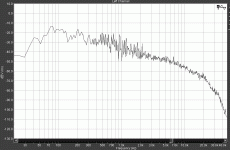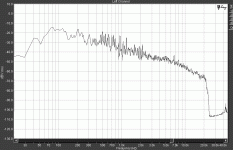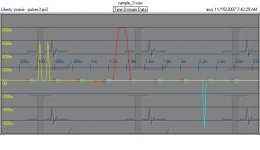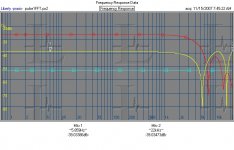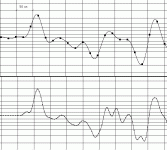Nico Ras :
Can you give examples when this has been proven over and over?
PMA:
It's easy to show that energy "exists" out to any frequency you want. What matters is (1) how much the energy is relative to other lower frequencies and (2) what hearing sensitivity is at the high frequency. I work with devices that depend on acoustic energies at over 1GHz (1 BILLION Hz). That doesn't mean or even imply anyone could ever hear it (I'd be interested in any evidence that they do -- evidence, not merely claims, of course!).
Another bit of inconvenient reality is that recordings are usually made with a strong emphasis on dynamic range, so "large capsule" microphones are what is often used to keep noise down (and also because people like the sound of them). Large capsule (1 inch or more diameter) mics have low resonance frequency, above which their response drops rapidly and their pattern becomes very beamy. These mics struggle to get to 20kHz, much less 50kHz. It is hard to find even a quarter inch microphone that has decent response beyond 20kHz. Toward higher frequencies, hearing sensitivity is rapidly dropping, mic sensitivity is radpidly dropping, phono cartridge sensitivity is dropping, tweeter sensitivity is dropping (and when not, it is so directional that it may as well not exist), are none of these factors significant?
This has also been proven over and over.
Can you give examples when this has been proven over and over?
PMA:
It's easy to show that energy "exists" out to any frequency you want. What matters is (1) how much the energy is relative to other lower frequencies and (2) what hearing sensitivity is at the high frequency. I work with devices that depend on acoustic energies at over 1GHz (1 BILLION Hz). That doesn't mean or even imply anyone could ever hear it (I'd be interested in any evidence that they do -- evidence, not merely claims, of course!).
Another bit of inconvenient reality is that recordings are usually made with a strong emphasis on dynamic range, so "large capsule" microphones are what is often used to keep noise down (and also because people like the sound of them). Large capsule (1 inch or more diameter) mics have low resonance frequency, above which their response drops rapidly and their pattern becomes very beamy. These mics struggle to get to 20kHz, much less 50kHz. It is hard to find even a quarter inch microphone that has decent response beyond 20kHz. Toward higher frequencies, hearing sensitivity is rapidly dropping, mic sensitivity is radpidly dropping, phono cartridge sensitivity is dropping, tweeter sensitivity is dropping (and when not, it is so directional that it may as well not exist), are none of these factors significant?
It sounds like there maybe many things in affect here. I agree with Nico that cymbals rarely sound like cymbals on recordings. But this could be the fault of the recording process, like microphones used or the speakers used to make the sound, but I can't see the standard cd format doing much to help this at all. Do you not have to capture all the energy and all harmonics for the original sound to be recreated properly? We supposedly have tweeters that can run up to 40-50kHz and amplifiers have been able to go higher than this easily, so why haven't we been able to resolve higher frequencies than the standard cd format?
If we want high fidelity reproduction I would think this would have to be done. Something like a cymbal has a high energy sound coming out of it and it is so week and minuscule in recordings.
Not that I entirely care, cause I will listen to anything as long as its energetic and fun, but like to have things as best as possible if able to.
If we want high fidelity reproduction I would think this would have to be done. Something like a cymbal has a high energy sound coming out of it and it is so week and minuscule in recordings.
Not that I entirely care, cause I will listen to anything as long as its energetic and fun, but like to have things as best as possible if able to.
That is why I gave this link to similar thread:
http://mixonline.com/mag/audio_resolution_project/
Just try it.
http://mixonline.com/mag/audio_resolution_project/
Just try it.
bwaslo said:Nico Ras :
Can you give examples when this has been proven over and over?
South African Broadcasting Corporation - New recording and playback equipment was evaluated for various new studios and listening tests performed on a large number of musicians and conductors during the selection and installation phases. I was one of the technical consultants.
On the other hand, I must confess, it is a bit late in life to slate CDs. We all have them and there are some advantages to be had that does enhance listening pleasure and that is the absence of surface noise, clicks, pops, etc.
Furthermore, you do not have to spend much in the tools and rituals of playing LPs, the sauce that is smeared, the counterweigths, the settling of tracking error, and all those good things that was synonymous with the hi-fi fanatic. Playing a single cut on an LP could take five minutes of ritual before the stylus actually hits the groove and then only to observe a curl of gundge being scraped out the groove by the stylus.
I do not promote that the sound quality of LPs are superior to CDs, that is totally debateable and probalbly has been for as long as CDs exist.
However, no recorded material actually surpasses live sound - again I must substantiate the claim; instruments that is not connected to a wire not passing though op amps, fuzz boxes, zener clamps and the like, but accoustic instruments that you can hear without it being plugged into a wall socket.
CDs cannot be faulted for electronically generated music as there is no-one on earth that can tell what it should sound like.
Furthermore, you do not have to spend much in the tools and rituals of playing LPs, the sauce that is smeared, the counterweigths, the settling of tracking error, and all those good things that was synonymous with the hi-fi fanatic. Playing a single cut on an LP could take five minutes of ritual before the stylus actually hits the groove and then only to observe a curl of gundge being scraped out the groove by the stylus.
I do not promote that the sound quality of LPs are superior to CDs, that is totally debateable and probalbly has been for as long as CDs exist.
However, no recorded material actually surpasses live sound - again I must substantiate the claim; instruments that is not connected to a wire not passing though op amps, fuzz boxes, zener clamps and the like, but accoustic instruments that you can hear without it being plugged into a wall socket.
CDs cannot be faulted for electronically generated music as there is no-one on earth that can tell what it should sound like.
Nico Ras said:it is a bit late in life to slate CDs.
All's not lost. If I am not wrong, master recordings are done at a much higher bitrate than CDs before they are downsampled to 16/44. I think its 24bit/96Khz ? or 192Khz ?
Maybe they will see the light of day, someday ?
I also recall some online services offering high bitrate original master recording downloads/purchases.
... but none o them gets brickwall. Brickwall is only good when no frequency component above its Fc exists.
Maybe when no frequqncy component you CARE about above fc exists. Surely you don't suggest that a brickwall cutoff at 10MHz would be significant? Because everything else, including hearing, have long fallen out by that freq.
An FIR near-brickwall still has perfectly linear phase up to cutoff. Has no effect on frequencies below cutoff. Yes, a scope with bandwidth beyond the cutoff will show squarewaves with Gibbs ripples, but filter the scope to cut out before the brickwall and they go away.
Anyway, all of those rolloffs (mic, ear, speaker, anti-aliasing filter) are tapering the response down (and a LOT, in practice) before the nyquist cutoff, so the actual system response is actually smoothly rolled off, not brickwalled. Excess concern about one piece of the chain that is effectively already in the stopband of many other pieces just makes no sense, I think.
__
In the link to the Resolution Project, I see they did some recordings with a custom made high rate/res system and believe high cutoffs are important; and some testimonials are quoted. But I don't find any actual data there -- no evidence that shows this making a difference, in objective terms, no tests to see if this can be heard when people aren't already told what they are listening to. I could be wrong, I'd be happy to re-read, can you point it out to me, or is there more on this project where actual tests were done rather than just the initial impressions and demonstrations? That report seems kind of preliminary. I have AES journals, was this project made into an academic study?
bwaslo said:
Maybe when no frequqncy component you CARE about above fc exists. Surely you don't suggest that a brickwall cutoff at 10MHz would be significant?
I hoped this was obvious. There is no problem with brickwall for audio when sample rate is 192kS/s.
2 example of the same music.
First - recorded at 24bit/96kHz
Attachments
bwaslo said:Then apply the cascaded rolloff responses of mics, ears and speakers to both curves. Is there a significant difference left between them then?
Everything has already been applied. This is the analog output spectrum.
Just to show what is audible. Try the attached file. It contains 3 impulses, in left channel. 1st contains 2 samples. 2nd contains 8 samples. 3rd contains just only one sample. All of them are audible. try your impulse response.
OK, Here are plots of your 3 'impulses'
-- Time domain (I zoomed in on each and overlayed so detail can be seen:
Attachments
And here are the spectra of the three 'impulses' (frequency domain), overlayed.
1) the wav file is sampled at 44.1kHz
2) the energy at low frequencies is as strong or stronger than at highest frequencies.
Why would you expect any of these to NOT be audible? There is every reason in the world why they should be. I guess I'm not seeing your point.
1) the wav file is sampled at 44.1kHz
2) the energy at low frequencies is as strong or stronger than at highest frequencies.
Why would you expect any of these to NOT be audible? There is every reason in the world why they should be. I guess I'm not seeing your point.
Attachments
Everything has already been applied. This is the analog output spectrum.
Sensitivity curve of ear applied too? Not of my ear, at least! I can't hear ANYTHING at 20kHz at any level I can produce with 100W and a horn tweeter.
you want to be careful when you say rolloff of the ear.
Why? Do you mean that the ear's sensitivity isn't rolled off at high frequencies??
South African Broadcasting Corporation - New recording and playback equipment was evaluated for various new studios and listening tests performed on a large number of musicians and conductors during the selection and installation phases. I was one of the technical consultants.
Nico Ras -- Do you have a link on that, or any published results about that? A google search turned up zilch on the subject for me. All controlled studies I've read about seem to have showed quite the opposite, including some differencing tests I've run myself.
I'm not trying to be too skeptical, actually, I'd really like to know about well controlled and highly repeatable tests that show what is claimed (I'd actually like to find evidence contradicting generally accepted ideas about hearing, if there is actual evidence -- rather than only hearsay, anecdotal and testimonial stuff, which are nearly meaningless and easy to get for any position one chooses).
Were the tests at SABC done in a way to verify that only the sound was being evaluated?
A colleague of mine has recorded a goblet jingle at 44.1kHz and 192kHz. The difference of reproduced sound is audible. This is my probably last post to this theme. We have done enough experiments confirming that 16/44.1 is unsufficient for high quality recording, and I do not intend to spend much time in useless argueing here.
Attachments
- Status
- This old topic is closed. If you want to reopen this topic, contact a moderator using the "Report Post" button.
- Home
- General Interest
- Everything Else
- Signals from musical instruments in time domain
